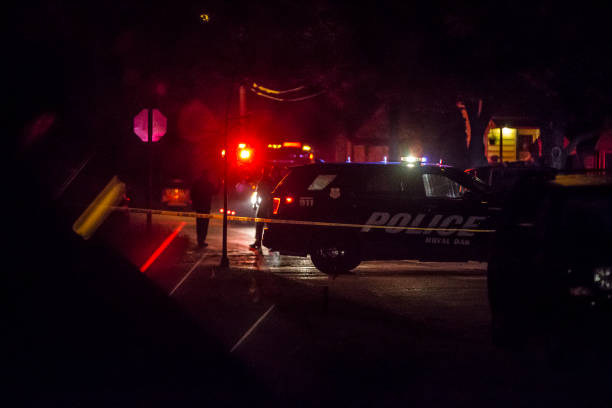In the late-night stillness of June 30, a violent act shattered the quiet of Baltimore’s 700 block of North Kenwood Avenue, claiming the life of 46-year-old Donte Chase. His name, now released by the Baltimore Police Department, joins a growing and somber list of homicide victims in a city grappling with the unrelenting toll of urban violence. The fatal stabbing, which occurred just minutes after 11:00 p.m., unfolded outside a residence in the city’s southeast corridor—a neighborhood marked by narrow rowhomes, modest porches, and the complex social networks of an urban landscape too often marked by tragedy.
According to official reports, officers were dispatched to the scene at approximately 11:09 p.m., following a call about a reported stabbing. When they arrived, they found Chase suffering from a stab wound to the body, though authorities have not yet disclosed the specific location or number of wounds. Emergency medical personnel were immediately called to the scene, where they worked quickly to stabilize him and transport him to a nearby hospital. Despite their efforts, Chase succumbed to his injuries and was pronounced dead shortly after arrival.
The Baltimore Police Department’s Homicide Unit has taken over the investigation, which remains open and active, with detectives now working to piece together what led to the deadly encounter. As of the latest update, police have not confirmed any arrests, suspects, or motives, and it remains unclear whether Chase and the person responsible for his death knew each other, or whether the attack was random, retaliatory, or personal.
Investigators are pursuing several leads. Standard procedure in such a case involves examining surveillance footage, both from city-owned security cameras and any private or doorbell video systems in the area. Given the residential character of the block, it is likely that detectives are canvassing nearby homes, speaking to potential witnesses, and attempting to reconstruct the timeline of events from the moment Chase was attacked to the moment paramedics arrived.
Authorities have not provided details on the type of weapon used, its recovery status, or whether any forensic evidence—such as blood trail patterns, discarded clothing, or fingerprints—has been collected. These details may be intentionally withheld to protect the integrity of the investigation or because they are still being processed by crime scene technicians.
What is known is that Donte Chase’s death has deepened the concern of community members already fatigued by Baltimore’s persistent struggle with violent crime. His murder adds to a grim 2025 tally that continues to rise. Though the city has implemented numerous violence reduction strategies, including community-based policing, youth intervention programs, and gun violence interruption initiatives, the ripple effects of violent altercations—particularly knife-related assaults, which often occur in the shadows of more heavily scrutinized gun violence—remain stubbornly impactful.
The silence around motive is perhaps the most pressing obstacle for homicide detectives at this point. Was this a domestic dispute? A neighborhood conflict? Or was Chase the victim of a targeted attack in the context of deeper street-level tensions? Without a public statement from those who knew him or from witnesses at the scene, investigators face the delicate task of constructing meaning out of silence and fractured detail.
In the wake of the killing, Baltimore Police have made direct appeals to the public, urging anyone with information to contact homicide detectives at 410-396-2100, or to leave anonymous tips through Metro Crime Stoppers at 1-866-7LOCKUP. These outreach efforts are critical; in many homicide cases, justice hinges not on forensic breakthroughs but on community willingness to speak.
While no statements have yet been issued by Donte Chase’s family, their silence is perhaps a reflection of the early stages of grief—a grief compounded by the suddenness and violence of his death. His funeral arrangements have not been made public, and it is not known whether Chase had children, a spouse, or extended family in the area. But what is evident is that someone has lost a brother, a son, a friend, and a neighbor, and that loss reverberates well beyond the yellow police tape left behind.
For the neighborhood surrounding North Kenwood Avenue, the killing disrupts the daily rhythm of life. Stabbings, unlike shootings, often suggest closer proximity, more intimate conflict, or unplanned escalation. They leave behind questions about rage, defense, or desperation. And in cities like Baltimore, where community healing efforts frequently intersect with law enforcement challenges, incidents like this one threaten to unravel fragile progress.
Police leadership has also faced increasing pressure to increase transparency in such investigations. Community trust—so essential to solving homicides—is a delicate currency, and each unsolved case undermines efforts to foster that trust. As the days progress, the absence of updates or arrests will likely intensify calls for accountability, both from the public and from advocates for policing reform.
In the meantime, investigators continue to do the painstaking work of assembling a coherent picture of the night’s events. This may include analyzing 911 call recordings, reviewing Chase’s recent activities, or checking for any known threats or disputes involving him in recent weeks. Every minor piece of data—text messages, voice mails, witness statements—could be the thread that unravels the mystery behind who killed Donte Chase, and why.
As Baltimore mourns another life lost to street violence, the hope remains that someone—perhaps a neighbor, a friend, or even a passerby—will come forward to provide the crucial piece of information that leads to an arrest, an indictment, and ultimately, a conviction. For the family of Donte Chase, such an outcome would not reverse the loss, but it would bring a measure of clarity and closure.
Until then, the investigation into Donte Chase’s fatal stabbing continues. So, too, does the city’s broader battle—to curb violence, build trust, and protect lives in a landscape where too many fall silent in the wake of another homicide.

